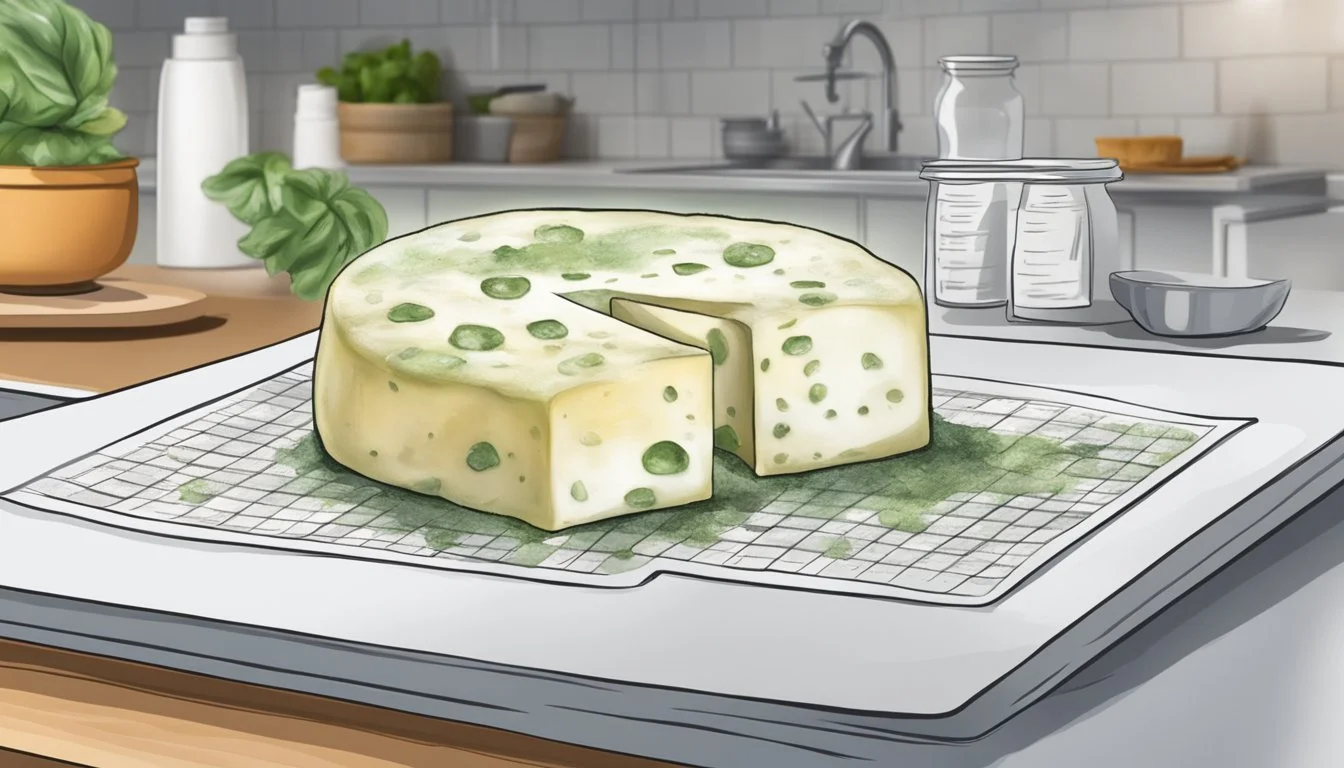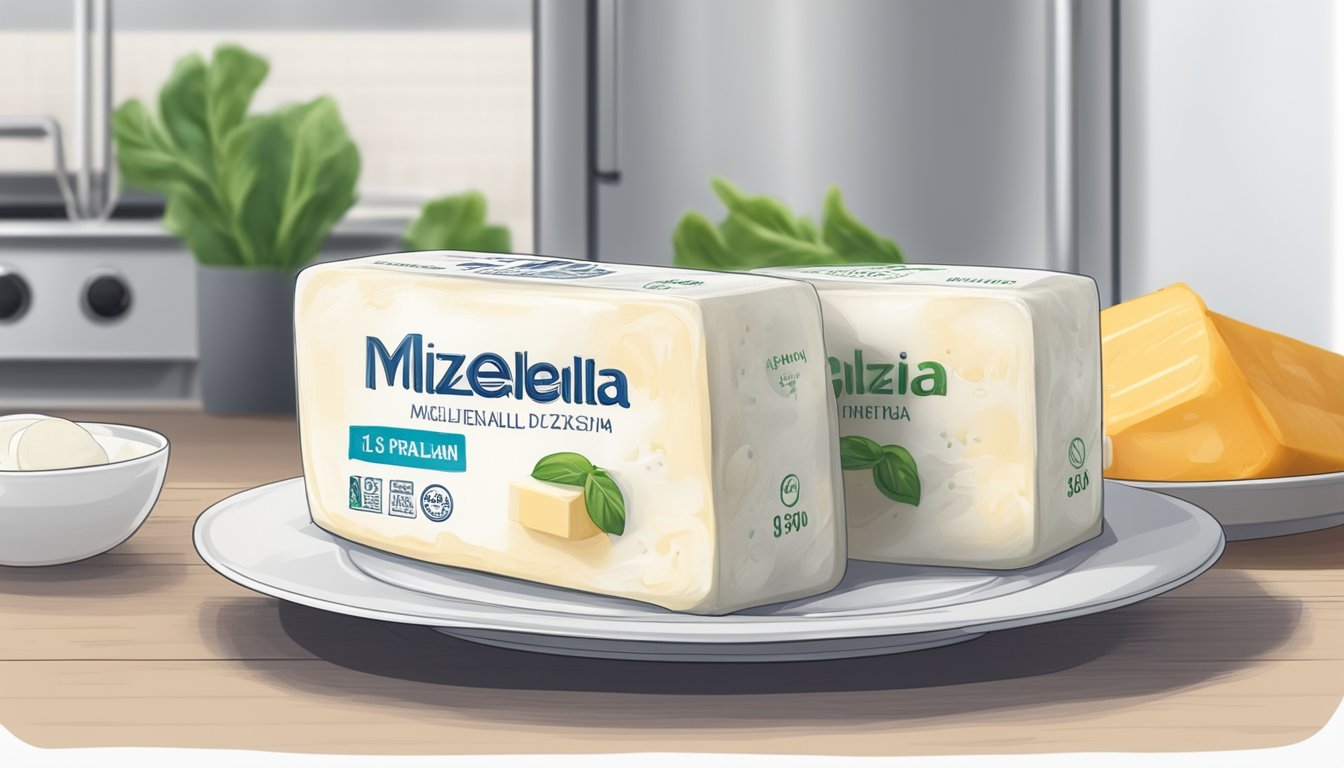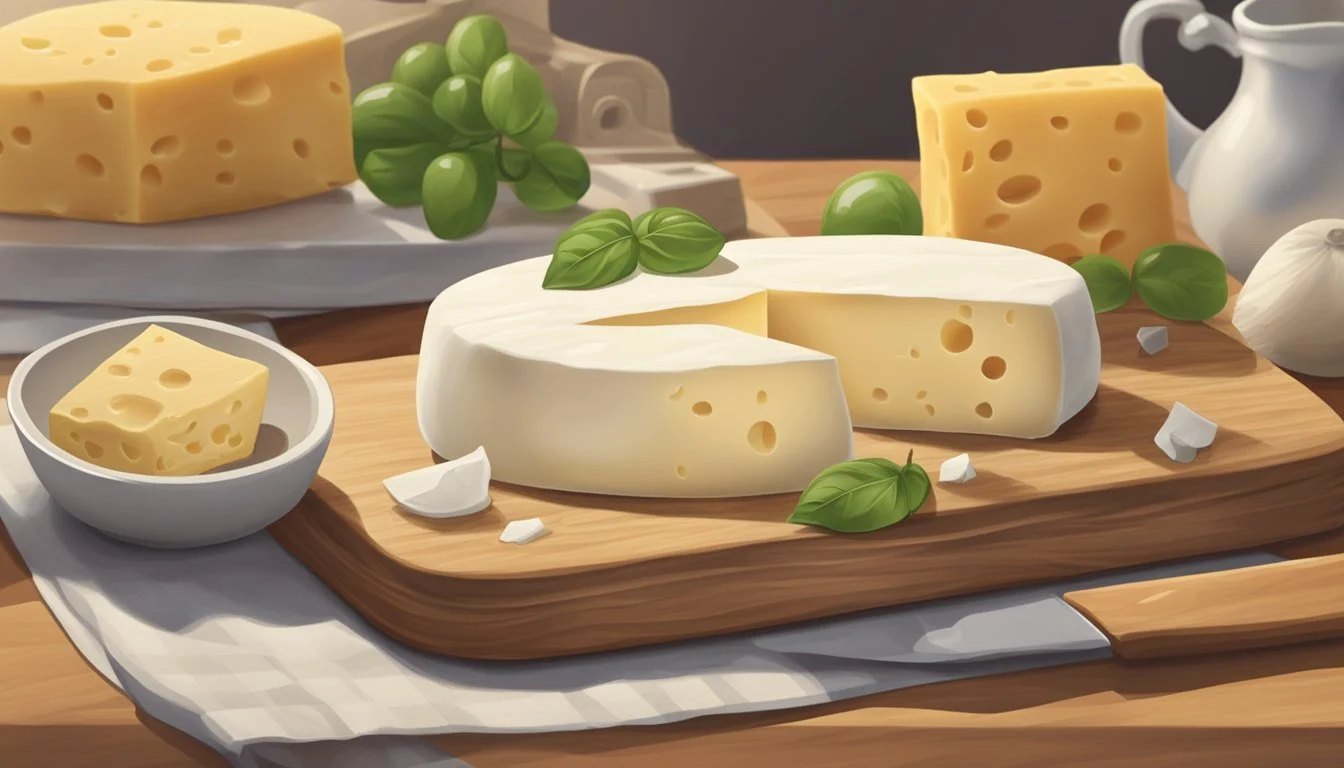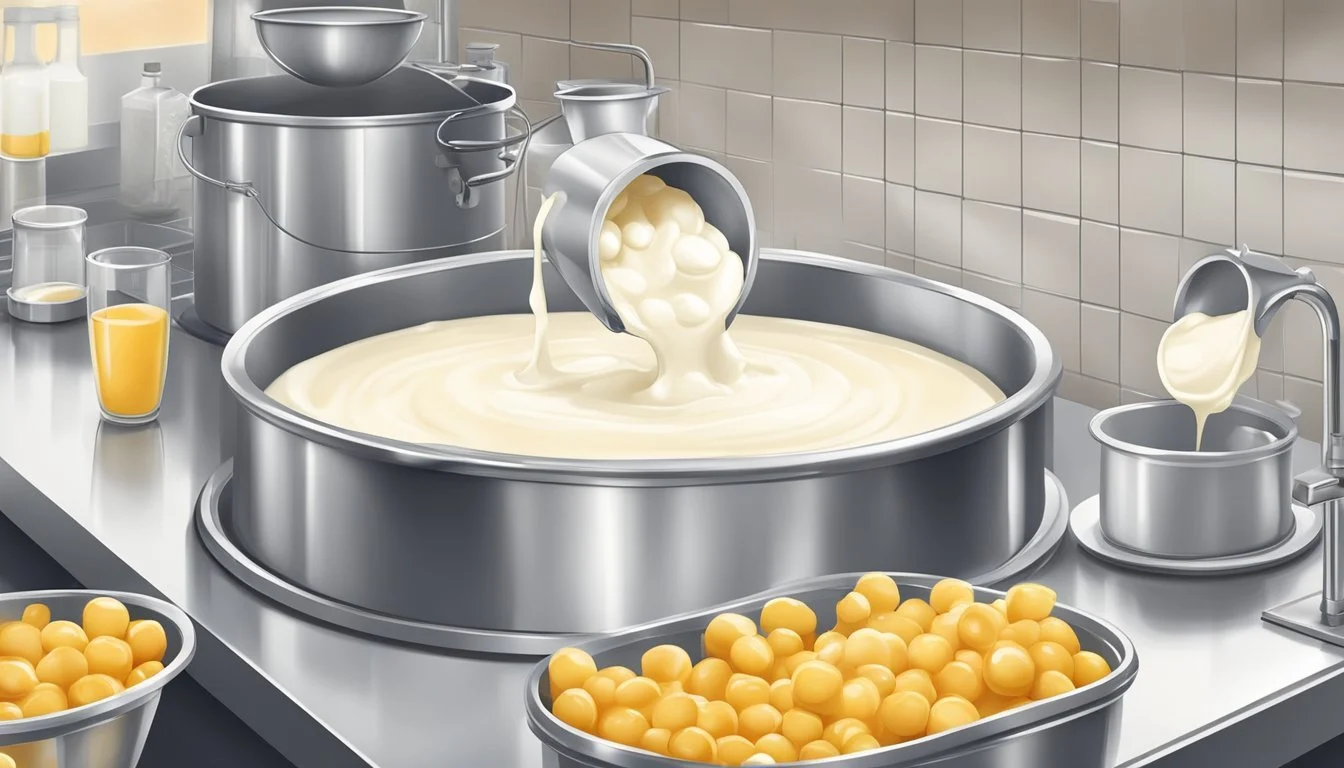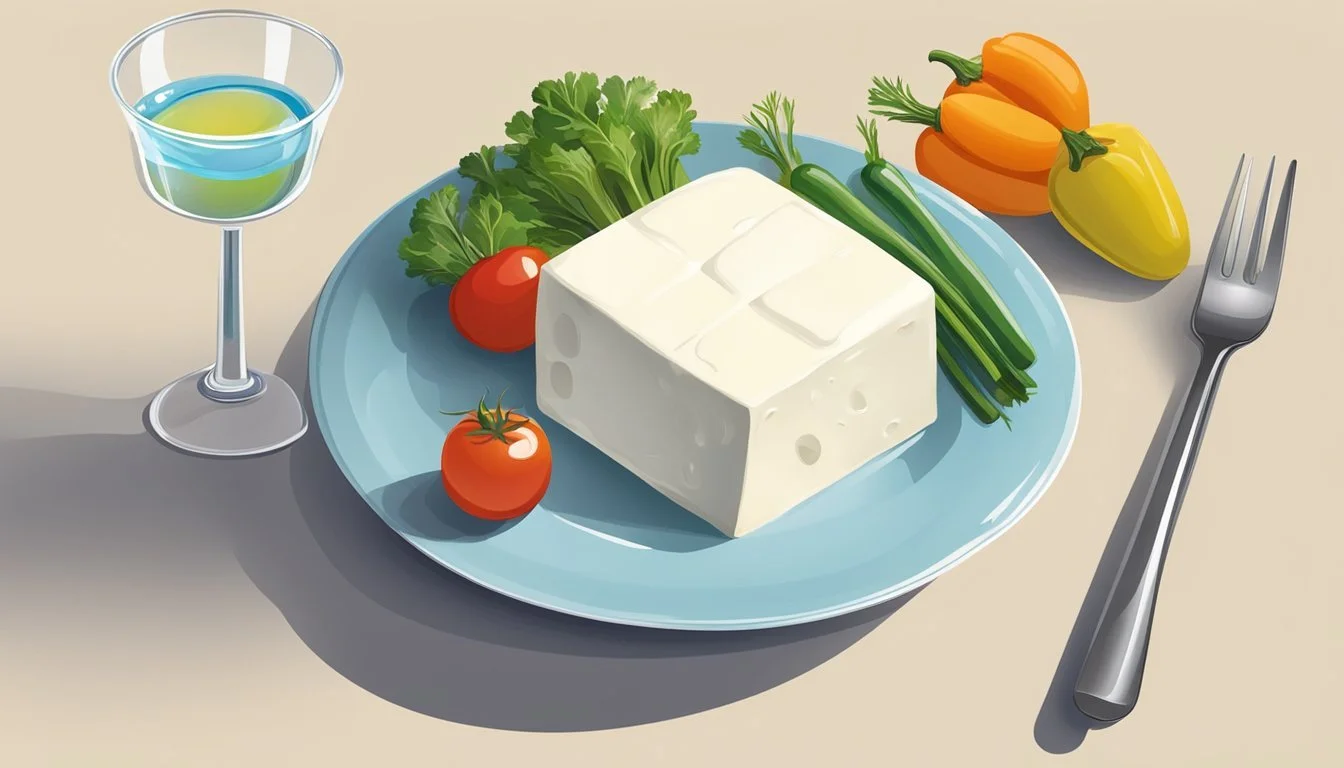How Long Does Mozzarella Last?
Shelf Life and Storage Tips
Mozzarella cheese, known for its mild flavor and melt-worthy qualities, is a staple in many kitchens and cuisines. This soft cheese, crafted from the richness of cow or buffalo milk, graces dishes from pizzas (What wine goes well with pizza?) to caprese salads (What wine goes well with caprese salad?). The shelf life of mozzarella cheese varies depending on its form and whether it has been opened. Unopened mozzarella can be expected to last beyond its 'sell by' date if kept refrigerated, typically staying fresh for 2 to 3 weeks for factory-sealed blocks and 4 to 6 weeks for refrigerated fresh mozzarella balls.
Once the packaging is breached and the cheese exposed to air, the countdown to consumption begins. Mozzarella in block form can remain suitable for eating for a few weeks after opening when stored correctly in the refrigerator. Fresh mozzarella, on the other hand, demands more urgent attention; it's ideal to use it within 3 to 5 days to savor its quality. To preserve its condition, it's advisable to keep the cheese in an airtight container or resealable bag, maintaining its moisture and protecting it from other flavors within the refrigerator.
The longevity of mozzarella cheese also differs between its various types. Shredded mozzarella, often used for its convenient meltability, can last between 2 to 4 weeks in the fridge due to added preservatives that extend its shelf life. For those who enjoy the smokiness of smoked mozzarella, this variety can be expected to maintain its quality for a similar duration when refrigerated. Proper storage remains key for all types of mozzarella, dictating not only how long they last but also ensuring they remain safe and enjoyable to consume.
Types and Characteristics of Mozzarella
Mozzarella cheese is distinguished by its moisture content and the type of milk used in production, which directly affects its flavor, texture, and shelf life.
Fresh vs. Low-Moisture Mozzarella
Fresh Mozzarella:
Moisture Content: High
Texture: Soft and creamy
Shelf Life: Shorter; consume within 3-5 days once opened
Uses: Salads, sandwiches, atop pizzas (adding late in the cooking process)
Moisture Content: Lower
Texture: Firmer and denser
Shelf Life: Longer; typically lasts up to a few weeks after opening
Uses: Gratins, stuffing, baking (melts well and browns)
Special Varieties: Buffalo, Smoked, and More
Buffalo Mozzarella (Mozzarella di Bufala):
Origin: Made from the milk of water buffalo
Characteristics: Richer and creamier than cow's milk mozzarella
Texture: Soft and delicate
Smoked Mozzarella:
Flavor: Infused with a smoky flavor
Texture: May vary, but usually has a firmer texture
Pairs with: Robust foods like grilled vegetables or meats
Additional Specialty Types:
Burrata: Fresh mozzarella shell with a creamy center that includes both mozzarella and cream.
Bocconcini: Small, individual servings of mozzarella.
Ciliegine: Cherry-sized mozzarella balls, often used in salads.
Buying Mozzarella
When purchasing mozzarella cheese, one must consider not just flavor and texture but also the quality and shelf-life indicated by labels and dates.
Choosing Quality Mozzarella
When selecting mozzarella cheese at grocery stores, shoppers should look for cheese that has a white to slightly yellowish color and a firm, yet slightly springy texture. High-quality mozzarella should smell fresh and have a subtle milky aroma without any sour or ammonia-like odors. Shoppers may find mozzarella in various forms, including:
Fresh mozzarella: Sold in balls, often in brine or vacuum-sealed packaging.
Mozzarella block: Great for slicing or shredding, with a firmer texture than fresh.
Shredded mozzarella: Convenient for cooking, but may contain anti-caking agents.
Understanding Labels and Dates
Grocery store products, including mozzarella cheese, come with labels and markers that provide essential information to guide consumers. Mozzarella cheese packaging typically includes:
Sell-by date: Tells the store how long to display the product for sale. Consumers can usually consume the product beyond this date if stored correctly.
Use-by or expiration date: Indicates the last date for optimal quality. After this date, the quality may decline, though the product might be safe to consume.
Fresh mozzarella should be consumed quickly after purchase due to its high moisture content, and proper refrigeration is necessary to maintain its quality. Block mozzarella has a longer shelf life and may retain quality for a few weeks past the labeled dates if unopened and refrigerated.
When examining labels, shoppers should also look for:
Signs of quality certifications, such as PDO (Protected Designation of Origin).
Ingredient lists for any additional preservatives that could affect taste or shelf-life.
By knowing what to look for in quality and understanding label information, consumers can make informed decisions that impact the flavors and longevity of the mozzarella cheese they purchase.
Storing Mozzarella
Storing mozzarella cheese properly extends its shelf life and preserves its taste and texture. Whether it's refrigerated or frozen, the key is controlling temperature, air exposure, and moisture.
Refrigeration Best Practices
For optimal quality, mozzarella should be kept between 34°F and 40°F. The refrigerator is ideal for short-term storage, particularly for fresh mozzarella, which is best consumed within a few days of purchase. Fresh mozzarella usually comes in a liquid solution that helps maintain its moisture content and should be kept in that liquid. For block or shredded mozzarella, the following steps can prevent spoilage:
Remove from the original packaging if opened.
Re-wrap tightly using plastic wrap to minimize air exposure.
If desired, add an extra layer of protection by wrapping with aluminum foil.
Place inside an airtight container or a ziplock bag to safeguard against odors in the fridge.
Always label and date the packaging for reference.
Freezing and Thawing Mozzarella
Freezing mozzarella cheese is suitable for long-term storage and can extend its shelf life up to a year. The process is fairly straightforward:
Freezing:
Pre-freeze shredded mozzarella on a baking sheet to prevent clumping.
Wrap blocks or pre-frozen shreds tightly in plastic wrap, ensuring all air is expelled.
Protect with a second layer of aluminum foil or place in a freezer-safe ziplock bag.
Store in the freezer, where the temperature should be kept at 0°F (-18°C).
Thawing:
Thaw frozen mozzarella in the refrigerator overnight, allowing it to gradually come to the right temperature.
Use thawed mozzarella as soon as possible to enjoy its best quality.
Shelf Life of Mozzarella Cheese
The shelf life of mozzarella cheese depends significantly on its storage conditions and whether the package has been opened.
Unopened Packages
Unopened mozzarella cheese, when stored in a refrigerator under 40°F (4°C), has varying shelf lives depending on its moisture content. Fresh mozzarella generally lasts for four to six weeks in the fridge before it passes its peak quality. Low-moisture mozzarella can have a shelf life of up to six to seven months when refrigerated properly. Customers are advised to adhere to the provided expiration date but should note that these products can be consumed for a short period beyond this date if they have been stored correctly and show no signs of spoilage.
After Opening
Once opened, mozzarella cheese's shelf life shortens considerably. Fresh mozzarella should ideally be consumed within three to five days for the best quality. However, if it's stored properly in the fridge at temperatures below 40°F (4°C), it may remain safe to consume for up to two weeks. Signs such as mold, sour smell, or an alteration in texture can indicate spoilage, and at that point, the mozzarella should not be eaten. Low-moisture mozzarella, once opened, can last for a few weeks if it's kept refrigerated and tightly wrapped to minimize exposure to air.
It is not recommended to keep mozzarella at room temperature for more than two hours as it can significantly increase the risk of bacterial growth and spoilage.
Signs of Spoilage
When assessing mozzarella for spoilage, it is crucial to be aware of the visual and olfactory signs that indicate the cheese is no longer safe for consumption.
Visible Mold and Discoloration
Mold Growth: Mold on mozzarella cheese typically appears as spots or patches that can be green, black, white, or even pink. These spots, if present, are a clear sign of spoilage and indicate that the cheese should not be consumed.
Discoloration: Healthy mozzarella should possess a white or slightly off-white color. A change to yellow, gray, or any other unnatural color for mozzarella points to potential spoilage and possibly bacterial growth.
Texture and Smell Changes
Texture: Fresh mozzarella has a soft and springy texture. If the cheese feels slimy, excessively hard, or chalky, these could be indicators of spoilage due to undesirable bacterial action.
Smell: A clean, slightly tangy smell is characteristic of good mozzarella. Any sour, ammonia-like, or otherwise unpleasant odors strongly suggest that the mozzarella cheese is moldy and has gone bad.
Health and Safety Considerations
When consuming mozzarella cheese, it's crucial to be aware of potential health risks associated with spoiled product and the need for proper food handling to prevent foodborne illnesses.
Risks of Eating Spoiled Mozzarella
Spoiled mozzarella cheese may harbor harmful bacteria such as Salmonella, E. coli, and Listeria, which can lead to food poisoning. The risk is higher with fresh mozzarella, which typically has a higher moisture content than low-moisture mozzarella. Warning signs of spoilage include:
Odor: A sour or unpleasant smell.
Texture: A slimy or excessively soft texture.
Color: Any discoloration or mold growth.
Consuming spoiled mozzarella can cause symptoms including nausea, vomiting, diarrhea, and abdominal pain. The elderly, pregnant women, infants, and those with compromised immune systems are particularly at risk.
Proper Handling to Prevent Foodborne Illness
To prevent foodborne illness, mozzarella must be stored and handled properly. This involves:
Storing temperatures: Keep mozzarella below 40°F (4°C).
Hygiene: Always handle cheese with clean hands.
Separation: Store away from raw meats to avoid cross-contamination.
Shelf life: Heed 'Best By' dates, consuming fresh mozzarella quickly and noting that low-moisture varieties may last significantly longer.
By adhering to these guidelines, consumers can minimize the risks associated with dairy products and enjoy mozzarella safely.
Usage Tips for Mozzarella
When cooking with mozzarella, chefs emphasize its versatility and meltability, making it a staple in Italian cuisine. It's not only a favorite topping for pizza, but its creamy texture and mild flavor make it well-suited for a variety of dishes.
Cooking with Mozzarella
Mozzarella's superb melting characteristics make it ideal for Italian dishes like lasagna, where it contributes to a rich, gooey layer that is both flavorful and visually appealing. When using mozzarella in lasagna or other baked dishes, it's recommended to shred or slice it evenly for consistent melting. For pizzas, using slices or dollops of fresh mozzarella provides the classic Neapolitan experience, with pockets of melty cheese that complement the tomato sauce and basil.
Lasagna: Layer evenly to ensure proper melt and coverage.
Pizza: Use slices or chunks to distribute cheese evenly.
Creative Uses Beyond Pizza
While mozzarella is synonymous with pizza, its use in Italian cuisine extends further. A Caprese salad is a simple yet elegant dish where mozzarella pairs with ripe tomatoes, fresh basil, olive oil, and balsamic glaze to create a refreshing appetizer or side. Sliced mozzarella can elevate sandwiches with a touch of Italian flair, and, paired with meats like prosciutto or salami, it can transform any sandwich into a gourmet experience. Incorporating mozzarella into different Italian dishes, like stuffing chicken breasts or topping baked eggplant, diversifies its use beyond the expected.
Caprese Salad: Alternate slices of mozzarella and tomato, topped with basil.
Sandwiches: Add to Italian meats for an enhanced flavor profile.
Mozzarella in Different Cuisines
Mozzarella cheese, originating from Italy, has transcended its traditional roots and found a place in numerous dishes worldwide, from classic Italian recipes to global culinary favorites.
Italian Mozzarella Dishes
In the realm of Italian cuisine, mozzarella cheese is a staple ingredient playing a central role in its gastronomy. One of the most revered Italian dishes, Caprese salad, showcases mozzarella's fresh and mild flavor. It elegantly pairs mozzarella di bufala—a variety made from the milk of water buffaloes—with ripe tomatoes, fresh basil, and a drizzle of extra virgin olive oil.
Another quintessential use of mozzarella in Italian cooking is within lasagna. Layers of pasta sheets alternate with rich tomato sauce, ground meat, creamy ricotta, and slices or shreds of mozzarella cheese, creating a hearty and beloved dish. The cheese's melting properties make it indispensable for achieving the signature gooey texture.
Mozzarella's Role in Global Recipes
Globally, mozzarella has cemented its status as the go-to cheese for pizzas due to its excellent meltability and subtle taste which complements a variety of toppings. From the smoky flavor of barbecue chicken pizza in the United States to the spicy zest of tandoori paneer pizza in India, mozzarella adapts to diverse flavor profiles, binding the ingredients together.
Moreover, mozzarella's versatility allows it to be featured in fusion dishes such as sushi rolls that use a slice of mozzarella in place of traditional fish, adding a creamy texture. As culinary boundaries expand, mozzarella continues to be integrated into international recipes, demonstrating its adaptability and enduring appeal.
Alternative Cheeses
In exploring alternatives to mozzarella cheese, one should consider factors such as texture, taste, and melting properties. These alternatives can offer varying flavors and functionalities for different culinary applications.
Substitutes for Mozzarella in Recipes
When recipes call for mozzarella, fresh mozzarella cheese is often sought for its creamy texture and mild flavor. However, its counterparts can serve as substitutes in certain contexts:
Brie cheese: With a similar creaminess to fresh mozzarella, brie can be used, keeping in mind its stronger flavor.
Goat cheese: For salads or pizzas, goat cheese offers a tangy taste and crumbly texture.
Cream cheese: Ideal for spreadable applications where a more pronounced creaminess is desired.
String cheese: A convenient snack alternative, shares mozzarella's stringy quality when melted but has a saltier profile.
To replicate mozzarella's attributes in dishes like lasagna or casseroles, it's essential to understand that the chosen cheese's melting qualities and flavor might differ.
Comparison with Other Cheeses
Different cheese varieties offer unique attributes that can contrast or complement mozzarella:
Cheese Type Texture Flavor Profile Melting Capacity Blue cheese Crumbly; veiny Pungent; sharp Melts but separates Brie cheese Soft; creamy Rich; earthy Melts smoothly Goat cheese Soft or firm Tangy Softens but may not melt evenly String cheese Stringy; chewy Mild; salty Melts stringily
When substituting, whether one opts for grated, shredded or block forms of these cheeses will affect the dish's texture. For shredded and grated forms, cheese distributes more evenly, while a block will provide a concentrated melt.
The Cheese-Making Process
The creation of mozzarella cheese is an intricate dance of science and tradition, requiring specific ingredients and conditions to yield the desired taste and texture.
How Mozzarella is Made
Mozzarella cheese starts its journey as a dairy product, which must first undergo pasteurization to ensure safety and consistency. Next, cultures containing beneficial bacteria are introduced to the milk to start the process of fermentation. These bacteria play a crucial role, as they acidify the milk and set the stage for curd formation. The milk then transitions into a curdled state, forming a delicate base for the cheese.
A key step in mozzarella cheese-making involves the addition of rennet, an enzyme that further coagulates the milk, leading to the development of a firmer curd structure. This curd is then cut into smaller pieces, instrumental in defining the cheese's final texture.
The Role of Rennet and Cultures
Rennet is essential for mozzarella cheese production as it precipitates the separation of curds from whey. It generally comes from the stomach lining of ruminant animals; however, vegetarian versions are available and widely used, deriving from microbial sources. The choice of rennet type does not significantly alter the final product’s quality, but it does provide options for those with dietary restrictions.
The cultures added to the milk contain specific strains of lactic acid-producing bacteria. These bacteria are responsible for the initial acidification of the milk and directly influence the cheese's flavour profile. As the bacteria consume lactose, they produce lactic acid, leading to a controlled environment where unwanted bacterial growth is suppressed, ensuring the safety and quality of the fresh mozzarella.
Environmental and Ethical Considerations
When discussing mozzarella's shelf life, it is crucial to consider the broader impact of its production, specifically from environmental and ethical standpoints. The following subsections will examine the influence of dairy farming practices and the options available for those seeking vegetarian-friendly cheeses.
Dairy Farming Impact
Dairy farming, as a significant contributor to environmental concerns, involves resource-intensive processes. The production of mozzarella, a dairy product, typically relies on cow's milk, although it can also be made from buffalo milk. The environmental cost is substantial, with factors like methane emissions, water consumption, and land use being prime concerns. These factors contribute to climate change and ecological degradation. Additionally, the treatment and welfare of dairy cattle are pivotal ethical issues, with consumers increasingly scrutinizing the conditions under which animals are kept.
Resource Usage and Emissions from Dairy Farming:
Water: Dairy farming requires large volumes of water for animal hydration, sanitation, and crop cultivation for feed.
Land: Substantial land area is needed for grazing cattle and growing feed crops.
Greenhouse Gases: Ruminants like cows produce methane, a potent greenhouse gas, during their digestive process.
Choosing Vegetarian-Friendly Cheeses
For those adhering to vegetarian diets, the presence of bacteria used in cheese-making does not typically present an ethical dilemma as it does not involve animal slaughter. However, vegetarians might consider the use of animal rennet—an enzyme traditionally sourced from the stomachs of ruminant mammals—to be problematic. Some mozzarella cheeses use rennet, while others may use vegetarian-friendly alternatives. Choosing cheeses labeled as "vegetarian" ensures they are made without animal rennet.
Considerations for Vegetarian-Friendly Cheese:
Rennet Source: Check labels for "microbial rennet" or "fermentation-produced chymosin," indicating vegetarian-friendly options.
Certification: Look for third-party certifications denoting vegetarian or vegan standards.
Storing Tips for Retailers
For retailers, maintaining the quality of mozzarella cheese in store displays is essential. It not only preserves the flavor and texture of the cheese but also helps in reducing waste and promoting sales.
Optimal Conditions for Store Displays
Retailers should store mozzarella cheese in refrigerators that maintain a temperature of 34°F to 40°F (1°C to 4°C) to ensure freshness.
Moisture Level: The cheese should be kept in its original packaging, which often includes a liquid to preserve moisture.
Store Displays: If the mozzarella is not submerged in a liquid, retailers should consider a sealed container with a small amount of water to prevent the cheese from drying out.
Inventory Rotation and Waste Reduction
Efficient inventory management is critical for minimizing waste and ensuring the availability of fresh mozzarella for customers.
First-In, First-Out: Adhere to a First-In, First-Out (FIFO) stock rotation system to ensure older inventory is sold before newer stock.
Storage: Regularly check the packaging for any signs of spoilage or damage, and remove affected items promptly.
By implementing these storage and rotation practices, retailers can offer the highest quality mozzarella to their customers while also managing their inventory effectively.
Buying in Bulk
Purchasing mozzarella cheese in bulk can be an economical choice, but it requires adequate storage practices to maintain freshness and prevent spoilage.
The best places to get these items are from your local markets, but if you can’t find any nearby, you can easily order mozzarella cheese in bulk online!
Cost-Effective Purchasing Strategies
When consumers buy mozzarella cheese in bulk, they often benefit from reduced prices. However, it's essential to assess consumption rates to determine the quantity one should purchase. They must measure the price per unit or ounce to ensure the bulk buy translates into actual savings. Additionally, purchasing in larger quantities demands a commitment to proper storage to extend the cheese's shelf life.
Long-Term Storage Solutions
For long-term storage, refrigerators and freezers become indispensable tools in preserving bulk mozzarella cheese. When refrigerating, individuals should place mozzarella in the original packaging or an air-tight container to prevent contamination from other foods and moisture loss. Sealed ziplock bags can also serve well, especially when portioning out the cheese for future use. For those looking to store mozzarella for an extended period, freezers offer a viable solution. Freezing mozzarella cheeseis possible, though it's best-suited for types that will be used in cooked dishes, as the texture might change once thawed. To freeze, one should wrap the cheese securely in cling wrap or aluminum foil, then place it in an air-tight container or heavy-duty freezer bag. This process helps prevent freezer burn and preserves the cheese’s quality.
I highly recommend purchasing air-tight containers online for a convenient shopping experience!
Mozzarella and Nutrition
Mozzarella cheese, as a dairy product, provides valuable nutrients, but it also comes with considerations for fat content and dietary impacts.
Health Benefits and Risks
Mozzarella offers several health benefits as it is a good source of calcium and protein which are essential for bone and muscle health. It also contains vitamins such as B12, important for red blood cell formation, and riboflavin, which aids in energy metabolism. Additionally, mozzarella has probiotics that support gut health. However, being a cheese, it also presents risks related to its sodium content, potentially contributing to high blood pressure if consumed in excess.
Fat Content and Dietary Considerations
Mozzarella has varying levels of fat depending on whether it's made from whole milk or part-skim milk. Here’s a brief overview:
Type of Mozzarella Fat Content Whole Milk Higher fat, contributing to a creamier texture. Part-Skim Reduced fat, a better option for those monitoring calorie intake.
Despite its fat content, mozzarella is generally lower in fat and calories compared to many other cheeses, making it a preferable choice in moderation for a balanced diet. However, individuals with lactose intolerance or dairy allergies should exercise caution or avoid consumption, as it can lead to digestive discomfort or adverse reactions.
FAQs About Mozzarella
When discussing mozzarella cheese, consumers often have questions regarding its shelf life, proper storage methods, signs of expiration like changes in texture or the presence of mold, and the effects of freezing on quality.
Common Questions and Expert Answers
How long can mozzarella cheese last unopened? Unopened mozzarella cheese, when stored in the refrigerator at a temperature below 40°F (4°C), can last from four to six weeks.
What is the shelf life of opened mozzarella cheese? Once opened, mozzarella cheese should be consumed within three to five days when kept refrigerated to maintain its quality. It can be safe to eat for up to two weeks depending on specific conditions of storage.
Can mozzarella cheese be frozen to extend its shelf life? Yes, mozzarella cheese can be frozen, which extends its shelf life up to three to four months. The texture may change after freezing, making it best suited for cooked dishes upon thawing.
How do you properly store mozzarella to ensure freshness? For optimal freshness, mozzarella should be kept in an airtight container with some cold water if it's fresh mozzarella, or in its original packaging or a tightly sealed plastic bag if it's low-moisture mozzarella, and placed in the refrigerator.
What are signs that mozzarella cheese has gone bad? Signs that mozzarella cheese is expiring or has expired include the presence of mold, sour smell, or an off-putting taste. The cheese's texture might also become dryer and more crumbly.
Does the expiration date on mozzarella cheese packaging matter? While the expiration date is a good indicator of the expected shelf life, mozzarella cheese can still be consumable past this date if it has been stored properly and shows no signs of spoilage.
Conclusion
Unopened mozzarella cheese typically has a longer shelf life compared to when it's opened. When kept refrigerated, an unopened package of mozzarella can generally last for 4 to 6 weeks past the 'sell by' date. However, shelf life may vary slightly based on the cheese's composition, the processing method, and the brand.
Once the mozzarella is opened, consumers should use it within 2 to 4 weeks when stored in the fridge to maintain quality and safety. Fresh mozzarella, due to its high moisture content, is best consumed within 3 to 5 days after opening. For the extended preservation of mozzarella, freezing is an option. Properly stored, frozen mozzarella is safe for consumption for up to 6 months, though the texture may change upon thawing.
Fridge (Unopened): 4-6 weeks past 'sell by' date
Fridge (Opened): 2-4 weeks for block mozzarella, 3-5 days for fresh mozzarella
Freezer: Up to 6 months
To ensure safety and the best sensory experience, it's advisable to:
Always store mozzarella in a refrigerator at below 40°F (4°C)
Keep mozzarella in its original packaging or an airtight container after opening
Check for any signs of spoilage, such as an off smell, discolored appearance, or mold before consumption
By adhering to these guidelines, consumers can enjoy their mozzarella cheese while preserving its quality and taste.


